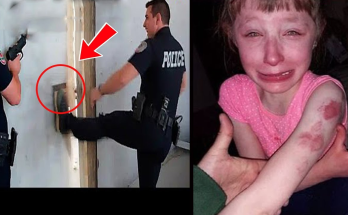Introduction: The Hidden Epidemic in Plain Sight
Domestic violence is often described as a silent epidemic—something that exists behind closed doors, where pain and fear remain hidden from public view. Yet, from time to time, an incident pierces through that silence and forces society to face a reality many prefer not to acknowledge.
One such moment came when an ordinary elevator ride transformed into a disturbing display of abuse. Security footage circulated widely online, capturing a violent outburst inside the confined space of an elevator. Viewers across the globe expressed shock, anger, and sadness as they witnessed the aggressor repeatedly targeting his partner.
Although the video was deeply unsettling, its impact could not be denied. It reignited conversations about the nature of abuse, the patterns that often precede such violence, the gaps in systems designed to protect victims, and the role that awareness and education play in prevention. More importantly, it served as a stark reminder: domestic violence is not just a private issue—it is a public crisis.
This article will explore the broader meaning of that incident. We will examine why abuse escalates, how it affects individuals and communities, why survivors often remain silent, what systemic reforms are needed, and how each of us can play a role in building safer environments.
Abuse in Public Spaces: When Silence Breaks
The viral elevator incident highlighted something important: abuse does not always remain hidden. While many people imagine domestic violence occurring only in the privacy of homes, it can unfold anywhere—workplaces, schools, public transport, and even within the confines of an elevator.
What shocked millions of viewers was not just the violence itself but the brazenness with which it occurred. Seeing abuse happen in such an ordinary, public setting shattered the illusion that domestic violence is distant or rare. It reminded society that abuse is closer than many realize—sometimes happening in plain sight, unnoticed or unchallenged.
Experts emphasize that the video was not an isolated event. For every recorded or viral incident, countless others occur silently, unreported and unseen. Many survivors endure years of harm without the world ever knowing. The difference here was visibility: people were forced to confront, even for a moment, the grim reality many survivors live with daily.
Why Abuse Escalates Quickly
To understand why situations like the elevator case escalate so rapidly, it is important to look at the dynamics of abusive relationships. Abuse rarely begins with physical violence. Instead, it often builds gradually through patterns of control and manipulation.
- Power and control: At the heart of most abusive relationships is an imbalance of power. The abuser seeks to dominate, often by controlling finances, restricting freedom, or monitoring movements.
- The cycle of abuse: Many survivors experience what psychologists call the “cycle of abuse”: tension builds, violence erupts, reconciliation follows, and the cycle repeats. Over time, this cycle becomes deeply ingrained, making it difficult to escape.
- Triggers in public spaces: In certain cases, abusers react strongly when they feel embarrassed, rejected, or challenged in front of others. What may begin as a verbal dispute can suddenly escalate into physical violence, as was seen in the elevator.
The key lesson is that abuse often develops beneath the surface, hidden by apologies, excuses, or brief periods of calm. But left unaddressed, it can—and often does—end in violence.
The Global Crisis of Domestic Violence
Domestic violence is not a local or isolated issue—it is a worldwide crisis. According to the World Health Organization, one in three women globally has experienced physical or sexual violence in her lifetime, most often at the hands of an intimate partner. Men, too, can be victims, though social stigma makes them less likely to report abuse.
The impacts extend far beyond the immediate victim:
- Children who witness violence often carry deep emotional scars into adulthood. Exposure to abuse increases their risk of anxiety, depression, and even repeating the cycle in their own relationships.
- Workplaces feel the effects, as survivors may struggle with absenteeism, decreased productivity, or job loss.
- Communities bear the financial and social costs of abuse, including higher healthcare expenses, demands on shelters, and strain on law enforcement.
This crisis transcends socioeconomic, cultural, and racial boundaries. No community is immune, and no society can afford to ignore it.
Why Survivors Stay Silent
One of the most common questions people ask after witnessing abuse is: “Why doesn’t the victim just leave?” The answer is far more complex than it may seem.
- Fear of retaliation: Research shows that leaving an abusive relationship often increases the risk of immediate danger. Abusers may respond violently to a partner’s attempt to leave.
- Financial dependence: Many survivors lack access to money, housing, or resources, especially if the abuser has controlled finances for years.
- Emotional ties: Abuse is often coupled with moments of affection, apologies, or promises to change. This manipulation creates confusion and false hope.
- Shame and stigma: Cultural and social attitudes may discourage survivors from speaking out, leaving them isolated and unsupported.
These barriers explain why systemic solutions—such as shelters, legal protections, and counseling—are so critical. Expecting survivors to “just leave” without providing resources overlooks the dangerous and complex reality they face.
Systemic Gaps and the Call for Reform
The elevator incident reignited debates about whether existing systems adequately protect survivors. Unfortunately, many shortcomings remain:
- Inconsistent law enforcement responses: Not all officers are trained to handle domestic violence cases with sensitivity and urgency.
- Judicial delays: Survivors may wait weeks or months for restraining orders or court hearings, leaving them vulnerable.
- Underfunded shelters: Many safe houses operate at capacity, often turning away victims in need.
- Lack of education: Society still struggles to recognize early warning signs, meaning intervention often comes only after violence has escalated.
Advocates for reform stress that protecting survivors requires a coordinated approach. This means stronger laws, better training for first responders, quicker legal processes, and expanded support services.
The Power of Awareness and Education
Awareness is one of the most powerful tools in combating domestic violence. The more openly society talks about abuse, the less power silence has to shield perpetrators.
- Schools can integrate education about respect, boundaries, and healthy relationships into their curricula.
- Workplaces can create policies to protect and support employees facing abuse at home.
- Media platforms can share survivor stories responsibly, fostering empathy without sensationalizing.
- Communities can organize bystander intervention programs to help people recognize and safely respond to signs of abuse.
Awareness campaigns, from social media movements to grassroots initiatives, help dismantle stigma and encourage victims to seek help.
Support Systems for Survivors
Thankfully, many organizations around the world provide lifelines for survivors of abuse. These include hotlines, shelters, counseling centers, and legal aid groups.
In the United States, the National Domestic Violence Hotline operates 24/7, offering confidential support. Globally, similar helplines exist, often staffed by trained advocates who can guide survivors through safety planning and connect them with local resources.
Common forms of support include:
- Emergency housing for survivors and their children.
- Legal advocacy to assist with restraining orders, custody issues, and court proceedings.
- Therapy and counseling to address trauma and rebuild self-esteem.
- Job training programs that help survivors achieve independence.
These services not only provide immediate safety but also empower survivors to rebuild their lives with dignity.
How Individuals Can Help
Domestic violence is not only a problem for policymakers and professionals. Every individual has the potential to make a difference:
- Listen without judgment when someone confides in you.
- Share resources such as hotline numbers or shelter information.
- Support organizations through volunteering or donations.
- Speak up if you witness violence, whether in public spaces or within your social circle.
Small actions—like offering a listening ear or sharing a resource—can create ripples of change that challenge the culture of silence around abuse.
From Outrage to Action
The viral spread of the elevator footage demonstrated how quickly public outrage can take hold. Yet outrage alone cannot solve the problem. True progress comes when anger is transformed into sustained action.
- Policymakers must prioritize legislation that strengthens protections and closes gaps in the system.
- Law enforcement agencies must invest in specialized training to respond quickly and sensitively.
- Communities must hold perpetrators accountable while fostering supportive networks for survivors.
- Society at large must continue to challenge harmful cultural norms that excuse or normalize abuse.
The real power lies not in momentary outrage but in consistent, collective action.
Conclusion: A Call to Break the Silence
The elevator incident was more than a viral video—it was a wake-up call. It reminded the world that domestic violence can erupt anywhere, at any time, and that silence enables abuse to thrive.
Instead of viewing such moments only as tragedies, society should see them as opportunities to confront difficult truths. Each story, each voice, and each act of support strengthens a growing movement demanding safety, justice, and respect for survivors.
Domestic violence is never acceptable. Building a safer future requires more than words—it requires action from policymakers, professionals, communities, and individuals alike.
By raising awareness, dismantling stigma, expanding support, and standing with survivors, we can work toward a world where relationships are built on respect and compassion, not fear and control.




